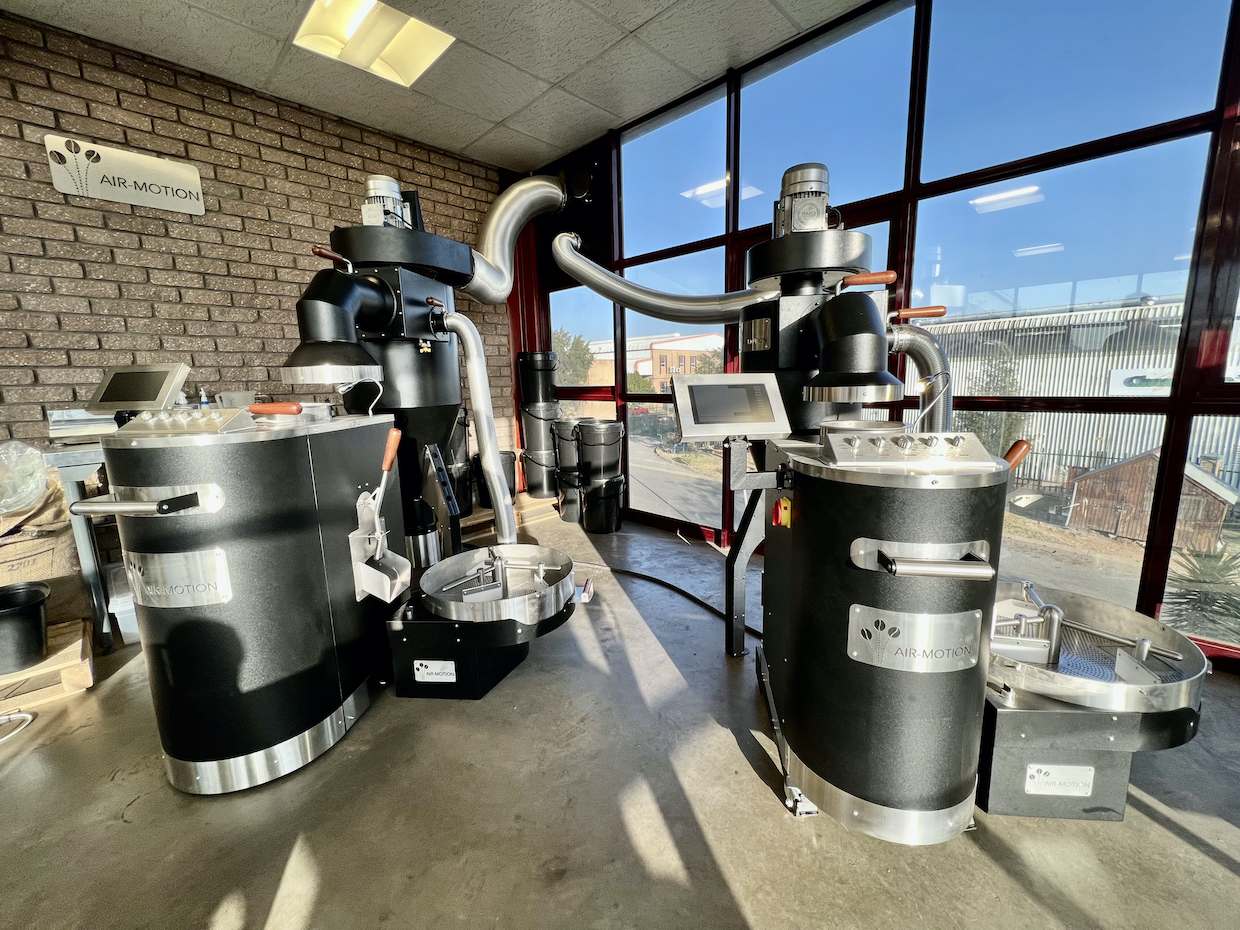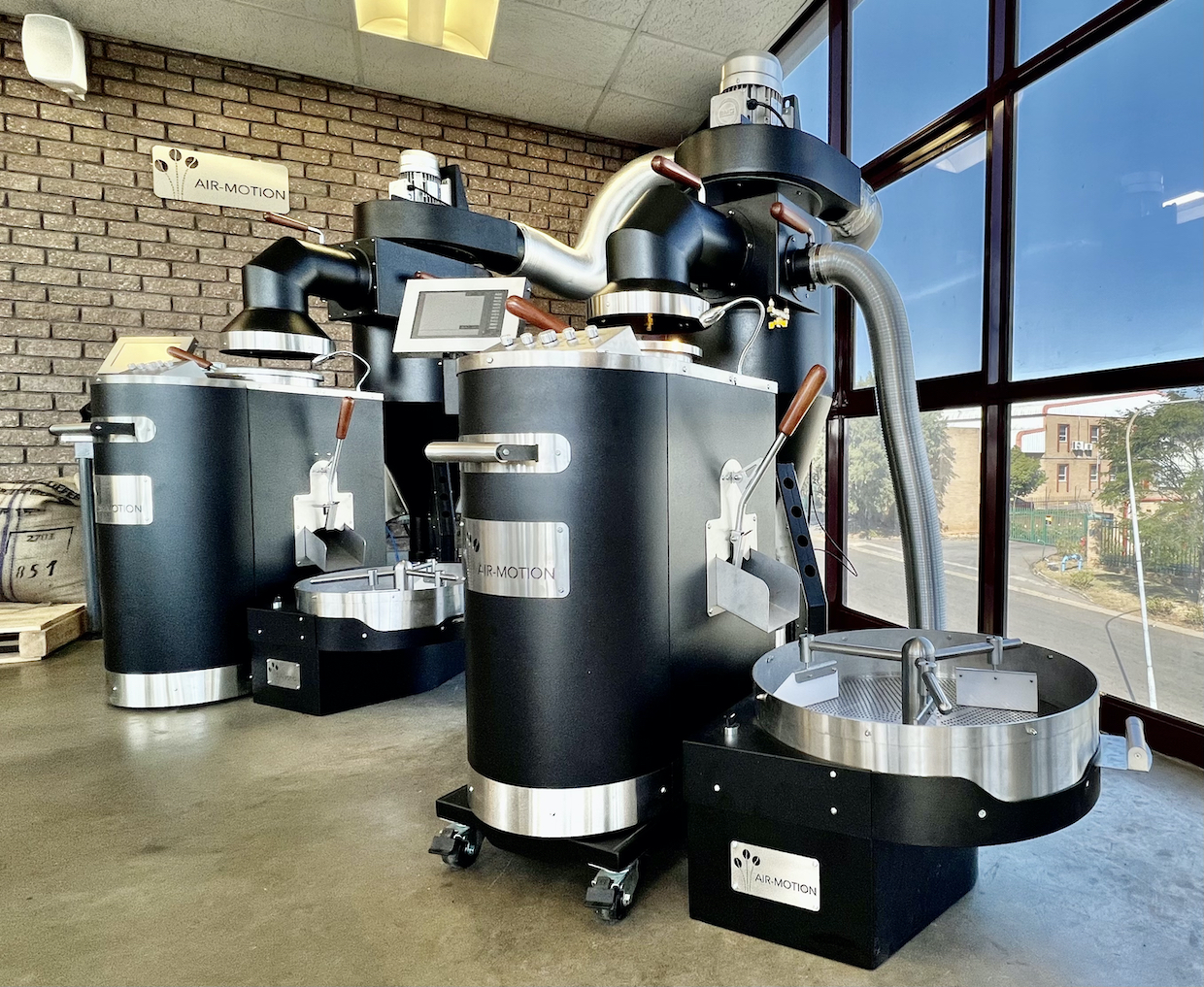South African electric fluid-bed roasting machine maker Air-Motion Roasters formally introduced itself to the United States coffee community at last month’s SCA Expo in Houston.
With new U.S. distribution and support through a partnership with Texas-based Coffee Equipment Pros, the Johannesburg-based company currently offers three core Air-Motion models: a 3-kilo-capacity machine priced at $27,500; a 6-kilo machine for $37,500; and a 12-kilo machine for $44,500.
All the machines feature an open-air gap between the roasting chamber and the upper manifold that allows fresh ambient air into the system, diluting and cooling emissions while also diminishing contaminants such as smoke, according to the company.
A screen at the top of the bean chamber prevents coffee from exiting while granting a clear view of the beans while roasting.
The size and location of holes within the lower structure of the bean chamber combine with the cooler air introduced at the top and a user-controlled fan to create a vertical fountain-like flow of beans through the chamber, with beans spreading outward at the top and descending peripherally.
Through a combination of settings, users can determine how much contact beans have with the metal of the roasting chamber.
“Drum roasters acknowledge that roasting with hot air — convection roasting — enhances flavor notes, cleanliness, clarity, smoothness, but they say it lacks body,” Air-Motion Roasters Founder and Designer Julian Platt told Daily Coffee News. “They say their body comes from conduction — the contact of bean to metal. But we do that. Our beans go up in the roast chamber in a column of heated air, they fan out and then they come down back to the bottom, touching the heated metal sides of the roast chamber. It’s almost equally convection and conduction.”
The system also involves radiant heat as the bean mass travels near the metal of the chamber, which is not directly heated due to displacement of the heating elements.
“The metal of our roast chamber is never in contact with our heat source. It is heated up by our air, so it’s never hotter than the air,” said Platt. “We’ve got a more gentle process on our roasting than a drum roaster, where you heat the actual metal, and the bean is in direct contact with that metal.”
The all-electric heat system also eliminates emissions associated with fossil fuel combustion. Air-Motion Roasters designed its own cyclone for separating chaff and other particles from the air while roasting, and the introduction of ambient air cools and dilutes emissions before release.
“The temperature coming up the middle here when we’re roasting goes [upward at] 450 degrees, and by the time it goes through the system, diluting that heat with the ambient air, it comes out at 105 degrees,” said Platt. “There’s no particle emission, and any smoke that it sucks out of here, it also dilutes. When it comes out the back, it’s negligible.”
The lower exhaust temperature may also simplify installation requirements according to Platt, through the ability to use silicone or other cheaper flexible materials for ducting.
Platt completed the first commercial prototype in 2018. The company was just about ready to launch when the COVID-19 pandemic hit. The first Air-Motion machine sold in June of 2020.
Now, the company has sold hundreds of machines across six continents. A 20-kilo-capacity machine is currently in development, and later this summer Air-Motion Roasters will launch its own proprietary AI-driven roasting automation software.
The program will partially guide or fully automate roasts based on live data and users’ past roasting decisions, sending alerts and making “choices” along the way to user-designed roast profiles.
“We don’t want to press a button and then your coffee runs with a pre-programmed profile and we have the same coffee. No,” said Platt. “You teach your roaster how to roast in your style, and I teach mine, and we have two different coffees. That is what it’s all about. You’ve got to be unique.”
[Note: This story has been updated. A previous version incorrectly described Platt’s professional background.]
Comments? Questions? News to share? Contact DCN’s editors here. For all the latest coffee industry news, subscribe to the DCN newsletter.
Related Posts
Howard Bryman
Howard Bryman is the associate editor of Daily Coffee News by Roast Magazine. He is based in Portland, Oregon.










Comment